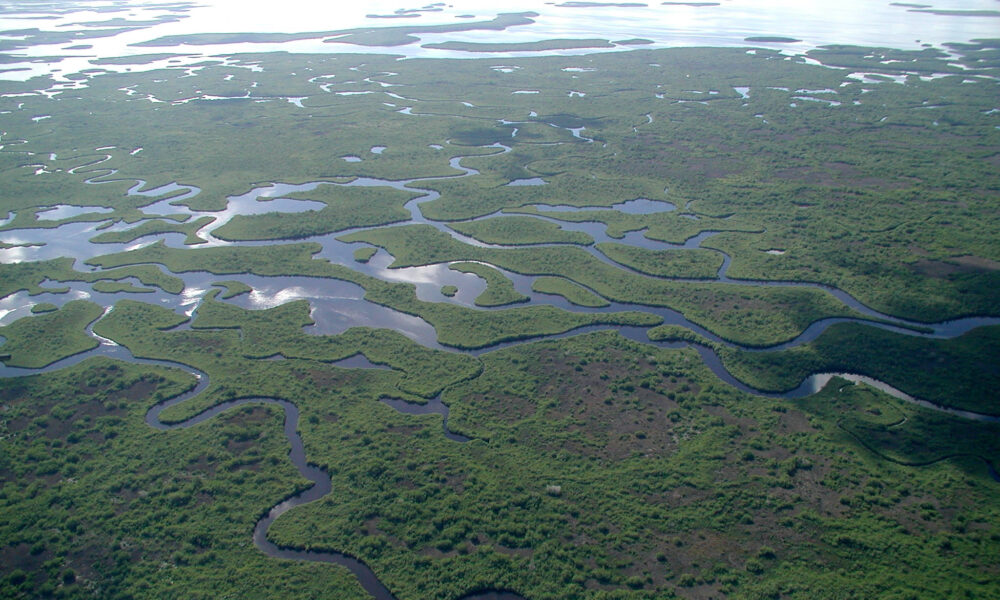Last year was a rough year for clean water. The Supreme Court took a hammer to the Clean Water Act with its decision in Sackett v. Environmental Protection Agency (EPA), stripping federal protections from countless wetlands and leaving these critical ecosystems exposed to devastating pollution and other damage from agriculture and other industries.
The Sackett decision was a tremendous loss for everyone who depends on clean water—that is, for all of us. Former EPA Administrator Carol Browner denounced the Sackett decision as “a major blow to the landmark Clean Water Act and the federal government’s ability to protect our people from pollution and its negative health side effects.”
For me and other clean water advocates, the Sackett decision was not only an attack on the health and safety of our environment, it also undermined years of hard work to protect US waters from polluting corporations and the attorneys, lobbyists, and trade associations that do their dirty work.
But industrial agriculture—the second-largest source of damage to US wetlands—celebrated Sackett, because the decision opened millions of acres of wetlands to agricultural development and unmitigated pollution.
What are wetlands and why do they matter?
Wetlands go by different names depending on whether they are natural or human-made and where they are located. From the swamps and bayous of the southern United States to the lagoons and rice paddies of southeast Asia, water defines a wetland. As National Geographic notes, “You’ll know you’re in a wetland when your shoe prints turn muddy and wet.”
While wetlands cover just 6% of Earth’s surface, these mighty ecosystems support 40% of all plant and animal life. Across the globe, nearly one in eight people depend on wetlands for fishing, rice farming, hunting, and tourism. In the United States, wetlands are crucial to the $5.6 billion commercial seafood industry, providing homes and breeding grounds for 75% of commercially harvested fish and shellfish species including bass and oysters.
But wetlands do more than house the plants and animals that support our economies. These critical habitats also reduce flooding by soaking up excess rainwater that would otherwise inundate nearby communities—one acre of wetlands can absorb more than a million gallons of floodwater! This translates to real savings: economists estimate that every square mile of coastal wetlands saves about $700,000 per year in property damage from storm surges and strong winds.
Wetlands hold water in a relatively still environment, which allows pollutants like sediment and chemicals to settle out and get trapped by the roots of wetland plants. This natural purification process cleans water before it slowly migrates into groundwater and surface waters like rivers. And again, this function saves us money: the EPA estimates that a single wetland, the Congaree Bottomland Hardwood Swamp in South Carolina, was so effective at removing pollution that it saved the nearby community from having to build a $5 million water treatment plant.
Wetlands even help fight climate change by acting as “carbon sinks,” absorbing climate-altering carbon dioxide (CO2) that would otherwise be released into the atmosphere. Wetlands—and especially the boggy wetlands known as peatlands—are incredibly effective carbon sinks, trapping and retaining almost a third of the world’s carbon. But when people drain wetlands to develop land for agriculture and urban development, that carbon is released as methane (CH4) and CO2, harmful heat-trapping gasses that fuel catastrophic climate change.
The turbulent history of federal wetland protection
We thrive when wetlands survive. But despite the well-documented benefits that wetlands provide to our drinking water, public health, and economy, these essential ecosystems are threatened by agricultural and urban development in the United States.
Since water makes a wetland, the primary federal law governing wetland protection is the Clean Water Act, which was enacted in 1972 to restore and maintain the “Nation’s waters” (33 U.S.C. 1251(a)). But the precise definition of “waters of the United States”—commonly shorthanded as “WOTUS”—has been the subject of ongoing legal controversy that has left sensitive wetlands sporadically unprotected from pollution and degradation.
Our seesawing national politics have contributed to the whiplash of changing federal wetland protections, and Supreme Court justices have disagreed with each other numerous times over the years about which waters do and don’t deserve federal protections under the law:
- Before 2001, most wetlands—along with streams, lakes, and other water sources—were recognized as falling under the protective sphere of the Clean Water Act.
- In 2001, the Supreme Court limited Clean Water Act protections to wetlands that are directly adjacent to navigable rivers and tributaries. Dissenting justices argued that the act’s protections should be interpreted as extending beyond navigable waters and their immediately adjacent wetlands.
- A Supreme Court case in 2006 introduced the “significant nexus” test, with one justice arguing that wetlands not connected to a navigable waterway on the surface can still be protected under the Clean Water Act if the wetlands “significantly affect the chemical, physical, and biological integrity of other covered waters.” But the court majority called the significant nexus test a “gimmick” and again limited federal protections only to wetlands abutting navigable waters.
- In 2015, under the Obama administration, the EPA and the Army Corps of Engineers expanded the definition of WOTUS so that more wetlands and smaller streams that can carry pollution into larger waterways were protected under the Clean Water Act. In response, 27 states sued, and the rule was put on hold.
- In 2019, under the Trump administration, the EPA and the Army repealed the Obama-era definition of WOTUS. A flurry of lawsuits from environmental groups, states, and homeowners ensued.
- In 2020, the EPA and Army under President Trump redefined WOTUS so that fewer wetlands and small streams were protected under the Clean Water Act. This new definition—called the Navigable Waters Protection Rule—was opposed by the EPA’s Science Advisory Board, which found it lacking “a scientific justification, while potentially introducing new risks to human and environmental health.” The newly narrowed WOTUS definition spurred multiple lawsuits, from states and cities to regional and national environmental organizations to the Navajo Nation and other Indigenous tribes (I filed an expert report supporting one of these lawsuits).
- In 2022, the EPA and Army under President Biden vacated the Navigable Waters Protection Rule. That same year, the Supreme Court heard oral arguments in Sackett v. EPA.
- And in 2023, the Supreme Court decision in Sackett once again reverted to a narrowed definition of WOTUS and, in the process, stripped countless wetlands of federal protections. In response, the EPA under President Biden reluctantly limited the protective power of the Clean Water Act, removing federal protections from 2.5 million acres of wetlands.
The Sackett ruling threatens millions of wetland acres, but its impact will filter far beyond these essential environments. As one dissenting justice warned, the Sackett decision undermines the very essence of the Clean Water Act, endangering waterways from the Mississippi River to the Chesapeake Bay.
Who wins when wetlands lose protections?
When the Sackett case reached the Supreme Court, industrial agriculture and other polluters joined states, members of Congress, and others in submitting legal documents in support of limiting the Clean Water Act’s power to protect vulnerable wetlands from pollution. These documents, called “amicus” (meaning “friend of the court”) briefs, are filed by entities with strong interests in a lawsuit and can significantly influence a court decision and thus public policy. A quick glance at the list of amicus briefs filed in the Sackett case provides a virtual who’s who of industries standing to gain by draining wetlands for corporate use, including home builders eyeing wetlands for future development of waterfront properties, timber companies looking for land to grow wood for profit, mining companies in search of riches underneath wetlands, and oil and gas companies hoping to hit liquid gold under wetland mud.
Some of the loudest voices against wetland protection in the case came from industrial agriculture and the professional associations that represent Big Ag corporations. Agricultural operations are the primary source of water pollution in US rivers and streams, and the second-largest source of wetland pollution. Fertilizers, pesticides, livestock waste, and other pollutants run off from agricultural fields and factories and into our waterways. To protect their clients’ right to pollute, 14 national agricultural organizations—including the American Farm Bureau Federation, the American Soybean Association, the American Sugar Alliance, the Fertilizer Institute, the National Corn Growers Association, and the National Cotton Council—argued in an amicus brief that the costs of protecting wetlands bit into their (considerable) profits. The Wyoming Stock Growers Association, representing the financial interests of livestock corporations, also argued against the “costly” burden of confining livestock activity to the 98% of state land that is not covered by wetlands. Additional briefs from Big Ag questioned whether the US Constitution allows for the Clean Water Act to protect wetlands at all.
Why are polluters so scared of clean water?
The Supreme Court’s majority opinion in Sackett characterized the Clean Water Act as “a potent weapon.” And indeed, it can be an effective weapon in the fight against water pollution from industrial agriculture and other corporations. But instead of recognizing the critical role that the Clean Water Act plays in addressing pollution, the majority opinion decried the “crushing consequences” that the act has on polluters.
And yes, it is easy to imagine that, for example, racking up nearly a million dollars in fines for repeatedly polluting sensitive waterways could affect a corporation’s bottom line. But that’s a good thing: when polluters are made to pay in a meaningful way, they are more likely to clean up their act—which is why wetlands need legal protections against the industries that pollute and destroy in the name of corporate profits.
Who is fighting for clean water?
Shortly after it was forced to rewrite the Clean Water Act to exclude millions of wetland acres from federal protections, the Biden administration signaled its ongoing support for these beleaguered ecosystems by joining the international Freshwater Challenge. The Challenge is a global initiative spearheaded by the United Nations to restore more than 864 million acres of wetlands by 2030.
Of course, global change starts at home. And while the Biden EPA suffered a severe setback in the Sackett decision, other laws offer policymakers alternative avenues for protecting our wetlands. For example, some state laws protect wetlands within their borders.
Federal laws and programs that govern wetland-polluting industries can also protect these vulnerable ecosystems. To help offset the harms that Big Ag poses to wetlands, the US Department of Agriculture (USDA) promotes conservation practices through programs such as Wetland Reserve Easements and the Farmable Wetlands Program. These programs can significantly reduce the harm that industrial agricultural practices inflict on wetlands by incentivizing farm owners to restore and protect these fragile ecosystems on their properties.
As Congress debates the next food and farm bill, UCS will continue to advocate for agricultural conservation programs that can help wrestle our land and water back from corporate polluters. The food and farm bill offers a unique opportunity to expand USDA programs that can restore wetlands—these vital but sensitive ecosystems that clean our water, protect our climate, and provide sustaining jobs and food—left vulnerable to agricultural pollution by the devastating decision in Sackett v. EPA.

